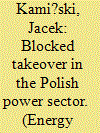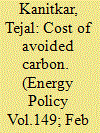| Srl | Item |
| 1 |
ID:
127869


|
|
|
|
|
| Publication |
2014.
|
| Summary/Abstract |
As the President of the Office of Competition and Consumer Protection refused to approve a government initiated takeover in the Polish power sector and the Court of Competition and Consumer Protection did not make a ruling on that case, the takeover was finally prohibited. In this context, the main aim of this paper is to carry out a quantitative analysis of the impact of the takeover in question on electricity prices and quantities, consumer and producer surpluses, dead weight loss and emissions. The scope of the study covers the Polish power generation sector and the analysis was carried out for 2009. A game theory-based electricity market equilibrium model developed for Poland was applied. The model includes several country-specific conditions, such as a coal-based power generation fuel-mix, a large share of biomass co-combustion, etc. For the sake of clarity, only four scenarios are assumed. The paper concludes that the declared synergy savings did not compensate for the increase in dead weight loss and the transfer of surplus from consumers to producers caused by increased market power.
|
|
|
|
|
|
|
|
|
|
|
|
|
|
|
|
| 2 |
ID:
177369


|
|
|
|
|
| Summary/Abstract |
Southern India houses over 49% of the total renewable energy capacity in India. This paper analyses the power supply situation in this region for year 2018 to evaluate the impact of renewable energy policies on energy costs and the resulting cost of avoided carbon. An optimisation model is built using GAMS. Model results show that the cost of absorbing renewable energy due to the “must run” policy for solar and wind energy plants ranges from $1.9/tCO2 to $4.5/tCO2 across states in the region, over and above the carbon tax of $5/tCO2 levied on all electricity consumers in India through the coal cess. ‘Must run’ status implies that the evacuation of power from solar and wind power plants should not be curtailed for factors other than grid or equipment safety. The total additional cost due this policy ranges from $200 to $350 million/year. Inter-regional transfer of renewable energy after meeting the mandated renewable purchase obligations in the region, is suggested as one possible route to reduce the financial burden on distribution utilities. This would reduce the unit cost of energy by about 1–7% across the states. Validating the model results against actual data for the year 2018 suggests that regulatory constraints and policy interventions have reduced the solution space for reasonable cost-based optimisation in Southern India.
|
|
|
|
|
|
|
|
|
|
|
|
|
|
|
|